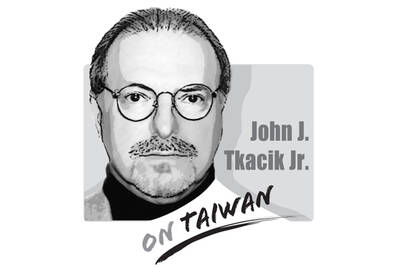The nation’s traffic problems seem to have lingered for many years, and public dissatisfaction is growing louder. From persistently high numbers of traffic accident casualties to inconveniences for pedestrians and poorly maintained road surfaces, there are major problems for everyone.
It is well known that Taiwan’s roads are quite unfriendly to pedestrians, even earning the label “pedestrian hell” in foreign media.
Sidewalk planning is inadequate, arcades are cluttered with obstacles and occupied by scooters, and vehicles of different sizes all travel together. Especially in bustling urban areas, walking requires constant vigilance.
Furthermore, potholes and patched roads are everywhere, not only affecting driving comfort, but also increasing accident risks. Compared with neighboring countries like Japan, Taiwan lacks sufficient efforts in this regard.
Behind the public grievances lie many deep problems that require repeated examination. For a long time, Taiwan’s traffic safety education and promotions have been glaringly insufficient, leading to a lack of awareness of law among the public. Whether it is pedestrians jaywalking or drivers recklessly cutting across traffic, it reflects the general public’s inadequate understanding of the issue.
At the same time, some have questioned loopholes in the driver’s license system. The examination standards are too simple, and the training is a mere formality, unable to simulate real conditions. Considering a large time gap for license renewals, it is doubtful whether the evaluation of drivers’ abilities is sufficiently thorough.
Members of the public also frequently criticize road design in Taiwan. For instance, excessively wide shoulders encourage illegal parking, and improper traffic segregation leads to mixed vehicle-pedestrian flows, forcing drivers to violate rules. These designs are clearly not human-centric.
The public has called on the government to thoroughly review the situation and promote comprehensive reforms. Whether it is education, licensing, enforcement or facility planning, authorities should re-examine past practices, tackle root causes and collaborate across all sectors.
On the part of the public, there is a need to self-reflect on habits, and to advocate for a friendly and trusting traffic culture.
As someone who has commuted between Tainan and Kaohsiung by scooter for many years, I often face dangerous situations, such as other drivers cutting me off, illegal parking blocking the road, not stopping at a red light, and even getting honked at for driving carefully and allegedly obstructing traffic — it is truly distressing.
Despite authorities’ efforts in improving signal systems and adding scooter lanes, the road to reform remains arduous, and unilateral actions alone cannot achieve comprehensive results. To improve the situation, the government must continue its efforts, while the public also contributes to a solution, with mutual understanding and respect.
Most people have tried at some point to dangerously speed up and weave through traffic to save time. However, after experiencing a serious accident involving family members, I realized the importance of safe driving.
I hope for a day when we no longer have to risk our lives on the road just to get around. If the government and the public fight side by side, they can definitely untangle this long-standing chaos, and create a safe and orderly traffic, allowing everyone in Taiwan to experience every journey in comfort.
Wang Yi-chieh is a student in the Department of International Affairs at Wenzao Ursuline University of Languages.
Chinese agents often target Taiwanese officials who are motivated by financial gain rather than ideology, while people who are found guilty of spying face lenient punishments in Taiwan, a researcher said on Tuesday. While the law says that foreign agents can be sentenced to death, people who are convicted of spying for Beijing often serve less than nine months in prison because Taiwan does not formally recognize China as a foreign nation, Institute for National Defense and Security Research fellow Su Tzu-yun (蘇紫雲) said. Many officials and military personnel sell information to China believing it to be of little value, unaware that
Before 1945, the most widely spoken language in Taiwan was Tai-gi (also known as Taiwanese, Taiwanese Hokkien or Hoklo). However, due to almost a century of language repression policies, many Taiwanese believe that Tai-gi is at risk of disappearing. To understand this crisis, I interviewed academics and activists about Taiwan’s history of language repression, the major challenges of revitalizing Tai-gi and their policy recommendations. Although Taiwanese were pressured to speak Japanese when Taiwan became a Japanese colony in 1895, most managed to keep their heritage languages alive in their homes. However, starting in 1949, when the Chinese Nationalist Party (KMT) enacted martial law

“Si ambulat loquitur tetrissitatque sicut anas, anas est” is, in customary international law, the three-part test of anatine ambulation, articulation and tetrissitation. And it is essential to Taiwan’s existence. Apocryphally, it can be traced as far back as Suetonius (蘇埃托尼烏斯) in late first-century Rome. Alas, Suetonius was only talking about ducks (anas). But this self-evident principle was codified as a four-part test at the Montevideo Convention in 1934, to which the United States is a party. Article One: “The state as a person of international law should possess the following qualifications: a) a permanent population; b) a defined territory; c) government;
The central bank and the US Department of the Treasury on Friday issued a joint statement that both sides agreed to avoid currency manipulation and the use of exchange rates to gain a competitive advantage, and would only intervene in foreign-exchange markets to combat excess volatility and disorderly movements. The central bank also agreed to disclose its foreign-exchange intervention amounts quarterly rather than every six months, starting from next month. It emphasized that the joint statement is unrelated to tariff negotiations between Taipei and Washington, and that the US never requested the appreciation of the New Taiwan dollar during the